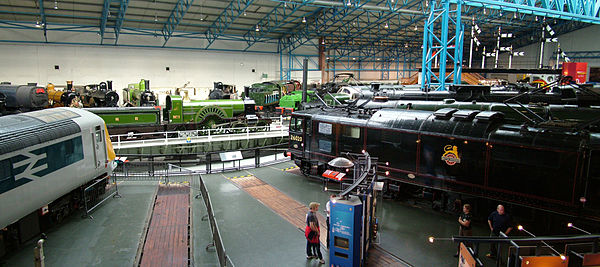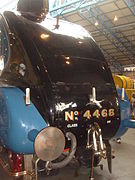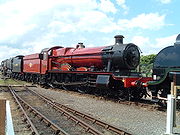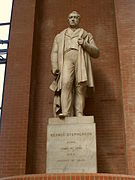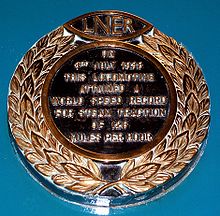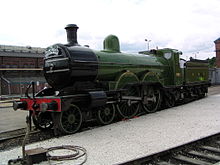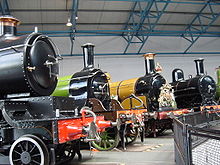- National Railway Museum
-
This article is about the British National Railway Museum. For other national railway museums see National Railway Museum (disambiguation)
National Railway Museum 
Established 1975 Location Leeman Road, York, North Yorkshire, England Type Railway museum Visitor figures 807,591 (2009)[1]
Director Steve Davies Website NRM website National Museum of Science and Industry National Media Museum · National Railway Museum (Shildon Locomotion Museum) · Science Museum (Dana Centre, Science Museum Swindon) The National Railway Museum (NRM) is a museum in York forming part of the British National Museum of Science and Industry and telling the story of rail transport in Britain and its impact on society. It has won many awards, including the European Museum of the Year Award in 2001. It is the home of the national collection of historically significant railway vehicles, as well as a collection of other artefacts and both written and pictorial records.
Contents
Overview
The NRM in York displays a collection of over 100 locomotives and nearly 200 other items of rolling stock, virtually all of which either ran on the railways of Great Britain or were built there. Also on the 20 acres (8.1 ha) site are many hundreds of thousands of other items and records of social, technical, artistic and historical interest, exhibited mostly in three large halls of a former motive power depot next to the East Coast Main Line, near York railway station. It is the largest museum of its type in Britain, the largest in the world being La Cité du Train in the French town of Mulhouse. It also has more visitors than any other British museum outside London.[2]
The NRM was established on its present site, the former York North locomotive depot, in 1975, when it took over the former British Railways collection located in Clapham and the York Railway Museum located elsewhere in the city; since then, the collection has continued to grow.
The museum is a short walk from the railway station in York, either on the road or via a staircase from the rear of the platforms. A "roadtrain" runs from the city centre (near York Minster) to the museum on Leeman Road. York Park and Ride also serve the museum from the car park entrance, on Line 2 (Rawcliffe Bar-York). Admission to the museum has been free since 2001. It is open daily from 10 am to 6 pm.
Locomotion – the National Railway Museum in Shildon, County Durham was opened in 2004 and is operated by the NRM in conjunction with Durham County Council. It houses more of the National Collection in a new building and a historic site around the former workshop of Timothy Hackworth and attracts a further 100,000 visitors annually.
National Collection
See also: List of rolling stock items in the UK National CollectionThere are approximately 280 rail vehicles in the National Collection, with around 100 being at York at any one time and the remainder divided between Locomotion at Shildon and other museums and heritage railways. The earliest are wagonway vehicles of about 1815. The permanent display includes "Palaces on Wheels", a collection of Royal Train saloons from Queen Victoria's early trains through to those used by Queen Elizabeth II up to the 1970s, among them some of the first rail vehicles to be set aside for preservation.[3][4][5] Other key exhibits normally to be seen at York include the 1846 Furness Railway No. 3 "Coppernob" locomotive, and the more modern express passenger steam locomotives London and North Eastern Railway Class A3 No. 4472 Flying Scotsman (added to the collection in 2004),[6][7] its streamlined sister Class A4 No. 4468 Mallard and London, Midland and Scottish Railway Princess Coronation Class No. 6229 Duchess of Hamilton.[8] Flying Scotsman is among the exhibits intended for operation on the National Rail network from time to time.
The museum has imported several major vehicles for display: the Chinese Class KF7 4-8-4 locomotive donated in 1981 was built in Britain and the Wagons-Lits sleeping car donated in 1980 had been used on the Paris-London Night Ferry service. The single exception to the rule of exhibits associated with Britain is the Japanese 0 Series Shinkansen leading vehicle which was donated to the museum by the West Japan Railway Company in 2001 and which now forms part of an award-winning display, and is the only Shinkansen vehicle on exhibit outside Japan.
Rail vehicles on display are exchanged from time to time with other organisations, and examples of new-build stock from the current industry sometimes visit the museum for short periods.
Other physically large exhibits are the Stockton and Darlington Railway Gaunless Bridge and several stationary winding engines used on railway inclines.
The many other two and three-dimensional elements of the collection include signalling equipment, road vehicles, ship models, posters, drawings and other artwork,[9] tickets, nameplates, staff uniforms, clocks, watches, furniture and equipment from railway companies' hotels, refreshment rooms and offices (including company seals) and a wide range of models, some of which are operated on the museum's O scale model railway (originated in 1982).[10]
The museum is also the repository for a large collection of engineering drawings from railway workshops and for official photographs. Thanks largely to the initiative of the late R. C. (Dick) Riley, these have been supplemented by the collections of a number of amateur photographers such as Eric Treacy and H. Gordon Tidey.[11][12][13][14] The museum’s own photographers have also worked on projects recording the contemporary railway, including the Channel Tunnel construction. In 1999/2000 the Museum began to collect recordings of former railway staff for a National Archive of Railway Oral History. It has also been given the archive of steam train recordings by Peter Handford.[15] The museum library houses a significant collection of railway periodicals,[16] timetables and official publications. The new Search Engine facility and archive has made these available for study and enjoyment to a wider range of visitors from early 2008. In 2009 the Forsythe Collection[17] of travel and transport ephemera was acquired for the collection.[18]
Origins
Although there had been amateur attempts to establish a national railway museum from the late 19th century, the National Collection today results from the fusion of two long-running official initiatives. One was led by the State museums sector, evidencing pioneering technology, and the other by the railway industry, in which the key contribution came from the North Eastern Railway as successors to the historic Stockton and Darlington Railway.
What became the Science Museum (London) collection was begun in the 1860s by the Patent Office,[19] whose museum included such early relics as Puffing Billy, Stephenson’s Rocket and Agenoria (sister locomotive to Stourbridge Lion), which was outhoused to York at an early date.
Preservation of redundant equipment by the railway companies themselves was a matter of chance. Sometimes relics were stored in company workshops and offices and some were destroyed as circumstances changed. Where put on public display at all the equipment was usually mounted on railway stations in a case or on a plinth. Coppernob at Barrow-in-Furness, Derwent and Locomotion at Darlington and Tiny at Newton Abbot were long-lived examples of this form of display.
The first railway museums were opened at Hamar in Norway (1897) and Nuremberg in Germany (1899). These inspired talk of doing the same in Britain, both in the 1890s and again in 1908,[20] but this came to nothing at that time. Indeed, two of the Great Western Railway’s earliest broad-gauge locomotives, North Star and Lord of the Isles, which had been set aside at Swindon Works, were cut up in 1906 for lack of space and several other relics were similarly lost in subsequent years.[21]
From 1880, J. B. Harper of the North Eastern had been collecting material much of which was exhibited on the occasion of the S.& D.R. centenary in 1925;[22] and which then formed the basis of a museum opened at York by the London and North Eastern Railway in 1928 under the curatorship of E. M. Bywell.
The smaller exhibits were housed in the old station buildings and the rolling stock and other large exhibits in the former locomotive erecting and repair shops of the old York and North Midland Railway (demolished after the museum closed).[23][24][25] Despite this however, the locomotives were displayed on short lengths of track acting as plinths, very much in traditional museum style. It was only when the NRM was formed that Britain acquired a rail-served railway museum where large exhibits could come and go with ease.
The collection was dominated by items from the North Eastern Railway, together with Great Northern Railway items. The other three ‘Big Four’ railway companies showed little interest in contributing to the LNER’s initiative, though eventually one locomotive representative of each did find its way there: the Great Western's City of Truro, London and North Western Railway Columbine and London, Brighton and South Coast Railway B1 Class Gladstone.
The GWR assembled a valuable collection of small objects, mounted privately in a long corridor at Paddington station, and in 1925 it built a replica of North Star. It preserved City of Truro[26] and Tiny in 1931 and Shannon in 1946.
The LMS had its own collection of small objects at Euston. It also began to build up a collection of historic locomotives, which included Caledonian 123, Columbine, Cornwall, Hardwicke, Highland 103, Midland 118 and Pet. Three others, set aside for preservation at Crewe Works, were scrapped in a change of policy in 1932. The LMS set aside one further locomotive (Midland 158A) before it was overtaken by nationalisation. It also succeeded in preserving a collection of historic royal saloons at Wolverton and built a replica Rocket, with six replica carriages, for the Liverpool & Manchester Railway centenary in 1930, and a replica Grand Junction Railway Travelling Post Office.
The Southern Railway inherited three preserved carriages of the Bodmin and Wadebridge Railway, long displayed at York and at Waterloo Station, but otherwise had no policy of preserving redundant equipment. Ryde was preserved from 1934 until cut up in 1940; the only other locomotive preserved by the Southern was Boxhill in 1947. (Gladstone was preserved by the Stephenson Locomotive Society as a private initiative and much later (in 1959) donated to the British Transport Commission.)
Great Northern Railway Class C1 990 Henry Oakley, first Atlantic in Britain, at its birthplace, Doncaster Works
The nationalisation of British transport in 1948 gave the opportunity for a more consolidated approach and a report was produced by the British Transport Commission in 1951.[27] Amongst other things this recommended a curator be appointed for the Commission’s holdings (John M. Scholes), retention of the York museum, creation of other regional museums (not carried out in the way proposed), a small relics display in the old Great Hall at Euston railway station (done on a temporary basis) and a large museum of collections elsewhere in London. For the latter, the former station at Nine Elms was originally favoured as a site, but what was eventually opened in 1961 was the Museum of British Transport in a former bus garage in Clapham.[28][29] An official list of locomotives for preservation was compiled,[30][31][32] and many were stored in sheds and works throughout the country, others being placed on loan to local authority museums. The 'Steam' Museum at Swindon still displays a large number of items from the National Collection, while the Glasgow Museum of Transport was also indebted to it, although many of the Scottish relics (including NBR K 'Glen' Class 4-4-0 No. 256 Glen Douglas currently at the Bo'ness & Kinneil Railway) no longer form part of the National Collection.[33]
The Beeching Report recommended that British rail should stop running museums, and a campaign was led by transport historian L. T. C. Rolt and others to create a new museum.[34] Agreement was reached under terms in the Transport Act 1968 for B.R. to provide premises to be occupied by a National Railway Museum which would be a branch of the National Museum of Science and Industry then under Dame Margaret Weston and the first English national museum outside London.
The building provided was the former locomotive roundhouse at York North (rebuilt in the 1950s), alongside the East Coast Main Line. The old museum and that at Clapham were closed in 1973. A Sainsbury's supermarket now stands on the Clapham site. Some items were retained in the capital and formed the basis of the London Transport Museum in Covent Garden. Some from York were re-located to the Darlington Railway Centre and Museum. Exhibits from the previous museums at York and Clapham moved to the new site were supplemented by vehicles taken from storage at Preston Park in Brighton and elsewhere and restored. Creation of the York museum was largely in the hands of its first keeper, Dr John Coiley,[35] his deputy Peter Semmens,[36] John van Riemsdijk[37] of the Science Museum and David Jenkinson.[38]
Growth 1975-2000
The museum was opened by Prince Philip, Duke of Edinburgh in 1975. The opening coincided with the 150th anniversary celebrations of the opening of the Stockton & Darlington Railway, for which several working exhibits were provided. By comparison with the museum’s predecessors coverage of ordinary passenger coaches and non-steam motive power was enhanced, but a popular new exhibit was ex-Southern Railway Merchant Navy Class No. 35029 Ellerman Lines sectioned to show the workings of a steam locomotive. The new museum received over a million visitors in its first year and was favourably received by critics.[39][40]
Significant events of 1979 were the restoration of a train of appropriate vehicles to mark the centenary of on-train catering[41][42] and an exhibition to mark the centenary of railway electric traction which drew attention to the museum's important collections in this area.[43] Also in 1979 the museum commissioned a working replica of Stephenson's Rocket for the following year’s Liverpool and Manchester Railway 150th anniversary.[44] This has since represented the museum at events around the world.
Another working replica was added to the collection for the 150th anniversary of establishment of the Great Western Railway in 1985: that of the 7 ft 0 1⁄4 in (2,140 mm) broad gauge locomotive Iron Duke.
Concerns about the condition of the concrete roof structure on the main building brought forward major changes to the museum in 1990. To maintain a presence at York, the former York goods depot across Leeman Road, already in use as a museum store (the Peter Allen Building), was configured to display trains as if in a passenger station, and this together with the adjacent South Yard was marketed as The Great Railway Show.[45] A further selection of exhibits formed the National Railway Museum on Tour on display for a season in the former Swindon Works.[46] Meanwhile, the main building was completely re-roofed and reconstructed retaining only one of the two original 1954 turntables.[47] It was reopened in 1992 as the Great Hall giving enhanced opportunities to display large artifacts such as railway signals, a footbridge and a segment from the Channel Tunnel. The former goods shed display was retained as the Station Hall.
In 1995 the museum joined forces with the University of York to create an academic research base, the Institute of Railway Studies (and Transport History).[48] It has also since partnered with York College to create the Yorkshire Rail Academy to teach vocational skills. The museum has also provided engineering apprenticeships and participates in partnerships aimed at delivering heritage skills training.[49]
In 1996 the Museum Garden was created incorporating a 7 1⁄4 in (184 mm) gauge ridable miniature railway. A playground was also added.
Continued concern over the condition of the remaining 1950s buildings on the site led to their replacement by The Works in 1999. This gave several functional areas: the Workshop, for maintenance of rolling stock; the Workshop Gallery, from which the public can look down on this work; a Working Railway Gallery, giving an insight into current and recent operation including a balcony overlooking York railway station hosting a set of monitors showing live feeds from the monitors at York IECC;[50] and the Warehouse which provides an innovative open storage area, which has proved popular with both public and museum professionals.[51]
Developments in the 21st century
In order to provide step-free access to the Workshop Gallery, the Museum Inclinator was constructed. Besides its primary function, this also served to demonstrate the workings of a funicular railway. To that end its workings are exposed in the style of a larger open air funicular railway, rather than being concealed in the fabric of the building as is more normal for intramural lifts.[52] Unfortunately, due to lack of spare parts, it is no longer working, and there are no plans to repair it.
2004 saw several major developments at the museum. Several railway anniversaries were celebrated by a major "Railfest".[53][54] Another took place from 25–30 May 2008 with a Sixties theme. The Locomotion museum was opened at Shildon, County Durham providing undercover collection care facilities for more rail vehicles (particularly freight wagons) from the museum's collection. In addition, the museum had a high-profile campaign, supported by the National Heritage Memorial Fund, to purchase Flying Scotsman[55] which arrived at the Museum as the climax of Railfest.
The first stage of a new centre providing easy access to the museum’s Library and Archives, called "Search Engine",[56][57] opened at the end of 2007.
From 18 July to 23 August 2008, a popular new venture was the staging by York Theatre Royal at the Museum of the play of E. Nesbit's The Railway Children, awarded five stars in The Guardian.[58][59] Following this success, it was repeated in 2009, from 23 July to 3 September, and the museum provided locomotives for subsequent performances at Waterloo International station and in Toronto.
Major plans under the name "NRM+" were made for refurbishing the Great Hall display, for which a preliminary Heritage Lottery Fund contribution was announced in 2009,[60] and seeking potential partners for a further outhousing project.[61][62] There are other partnerships for development of the museum estate and the land around it (much owned by Network Rail) as "York Central"[63] but the economic situation during 2009 put these particular plans in abeyance.[64] The NRM+ project was cancelled in April 2011 due to lack of success in assembling the funding package.[65] However, major changes to the displays in the Station Hall began later in 2011.[66]
Policies
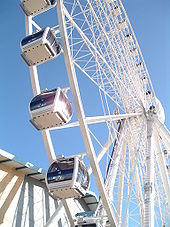 The Yorkshire Wheel, sited from 2006 to 2008 at the NRM, was one of the museum's fund raising initiatives
The Yorkshire Wheel, sited from 2006 to 2008 at the NRM, was one of the museum's fund raising initiatives
Occasional criticisms of aspects of the museum, such as that it has devoted insufficient attention to modern traction;[67][68][69] that it was neglecting scholarship in favour of commercialism;[70] or that its photographic collections constitute a "black hole",[14] do not always take into account the financial constraints under which the museum operates:[71] its Grant in Aid from the Department for Culture, Media and Sport amounts to £6.50 per visitor, which is used more cost-effectively but delivers much less overall income than for comparable London museums and it depends on money-making initiatives such as the Yorkshire Wheel, which operated at the museum from 2006 to 2008, and visits from Thomas the Tank Engine as chronicled in Thomas and the Great Railway Show. The museum has also suffered a few thefts of objects.[72]
The museum can be allocated material from the railway industry by the Railway Heritage Committee. Because of the diversity of material falling potentially within the museum's collection policy and the problems of caring for it, decisions on acquisition of new items for the collection can be difficult.[73][74] There has been a tradition within the museum of treating rolling stock as if it were still in railway service and unquestionably capable of undergoing heavy repairs and restoration, and many of the museum's locomotives have been operated in preservation on the main line, heritage railways or at the museum.[75][76] More recently, there have been moves to less interventionist forms of conservation in some cases.[77]
Since 1977, the Friends of the National Railway Museum have been in existence as a group to give financial and other support to the museum, such as financing the restoration of Duchess of Hamilton.
The 1990 "Great Railway Show" won the Museum of the Year award and in 2001 the museum gained the European Museum of the Year Award. It has also won White Rose awards from the Yorkshire Tourist Board, and in recognition of the several major developments in 2004 was given the Heritage Railway Association's Peter Manisty Award.[78]
Online connections
The National Railway Museum has a working relationship in the form of a presence on the National Preservation forums. Members and Readers are able to talk and comment directly to members of the staff. Providing both feedback and constructive criticism, a valuable source of information for the museum. Members of staff can usually answer questions when they are not busy and are part of the National Railway Museum group.[79]
Locomotives
These are a few of the Museum's locomotives (listed by operational state, and then by date the design was introduced).
- Operational steam locomotives
- GWR 3700 Class 4-4-0 No. 3440 City of Truro. In service and usually on loan to other railways; when it is not touring it is seen at York. Boiler certification expires in 2014.
- LNWR G Class ("Super D") 0-8-0 No. 49395. In service and usually on loan to other railways; when it is not touring it is stabled either at York or Crewe. Presently based on the North Yorkshire Moors Railway. Boiler certification expires in 2015.
- Great Central Railway O4 Class 2-8-0 No. 63601. Currently working on the Great Central Railway. Boiler certification expires in 2012.
- SR N15 Class 4-6-0 No. 30777 Sir Lamiel. Currently kept at the Great Central Railway where it is operational and works on the national network. Boiler certification expires in 2016.
- SR Lord Nelson Class 4-6-0 No. 850 Lord Nelson. Currently working on the Mid Hants Railway. Boiler certification expires in 2016.
- British Railways Standard Class 7 "Britannia" 4-6-2 No. 70013 Oliver Cromwell. Currently based on the Great Central Railway but frequently operates on the mainline.
- Steam locomotives under overhaul
- LNER Class A1/A3 4-6-2 No. 4472 Flying Scotsman. Having undergone a major overhaul largely in the NRM workshops, late discovery of problems was expected to delay return to mainline service in LNER Apple Green livery until late spring 2012.[80][81][82][83][84][85]
- Steam locomotives on static display
- Stephenson's Rocket 0-2-2 Rocket. Two replicas are in the York collection, one built for operation (rebuilt 2009-10) and one sectioned. (The original is with the parent body, the Science Museum in London.)
- NER No. 66 Aerolite. On static display in York since 1934.
- GWR 6000 Class 4-6-0 No. 6000 King George V. Moved to York in September 2008 after changing places with No. 92220 Evening Star.
- LMS Stanier Class 5 4-6-0 No. 5000. On static display.
- LNER Class V2 2-6-2 No. 4771/60800 Green Arrow. After many years of being a popular operation engine, her boiler certificate was due to expire Spring 2008, but failed beforehand on the North Yorkshire Moors Railway. In need of extensive repairs to her one-piece three cylinder block, she is unlikely to steam again due to cost and NRM policy. Returned to York after a two year loan to Locomotion at Shildon.
- LMS Princess Coronation Class 4-6-2 No. 6229 Duchess of Hamilton. Recently returned to the NRM after being re-streamlined. It is displayed in the exhibit, Streamlined: Styling an era. There are plans to return the locomotive to steam in the near future.
- LNER Class A4 4-6-2 No. 4468 Mallard. Restored to steam for a time from 1986; now on static display. Unlikely to run again due to exhibit popularity and the fact that all the other A4s in the UK have been restored to working order.
- SR Class Q1 0-6-0 No. C1. On static display. However it is possible it will return to the Bluebell Railway, where it was based for many years, to be returned to service.
- BR standard class 9F 2-10-0 No. 92220 Evening Star, the last steam locomotive built for British Railways. On static display and not expected to return to working order. Recently returned to York after a two year loan to Steam - Museum of the GWR, Swindon.
- Steam locomotives located away from York
- GWR 4000 Class 4-6-0 No. 4003 Lode Star. Recently taken to STEAM - Museum of the GWR, Swindon where she swapped places with Evening Star.
- SR Schools class 4-4-0 No. 925 Cheltenham. Recently taken to Eastleigh Works for asbestos removal. She will then move to the Watercress Line where she will be restored to working order.
- Robert Stephenson and Hawthorns 0-4-0ST No. 15 Eustace Forth. Outstationed at Locomotion, Shildon to help maintain a working locomotive presence there.
Heads of museum
Head Served Dr John A. Coiley 1974–1992 Andrew Dow 1992–1994 Andrew J. Scott CBE 1994–2009 Steve Davies MBE 2010– See also
- List of British railway museums
References
- ^ "Visits Made In 2009 To Visitor Attractions In Membership With ALVA". Association of Leading Visitor Attractions. http://www.alva.org.uk/visitor_statistics/. Retrieved 21 May 2010.
- ^ Monthly museum & gallery visits figures of the Department for Culture, Media and Sport; also note Government Funded Museum Visitor Numbers Live Online, by David Prudames, 7 October 2004, culture24.org.
- ^ Kumar, Amba (1997). Stately Progress: Royal Train Travel since 1840. York: National Railway Museum. ISBN 1-872826-09-1.
- ^ Jenkinson, David; Townend, Gwen (1981). Palaces on Wheels: Royal Carriages at the National Railway Museum. London: H.M.S.O. ISBN 0-11-290366-5.
- ^ Ellis, C. Hamilton (1953). Royal Journey. London: British Transport Commission.
- ^ Hughes, Geoffrey (2004). Flying Scotsman: the people’s engine. York: Friends of the National Railway Museum Enterprises. ISBN 0-9546685-3-7.
- ^ Roden, Andrew (2007). Flying Scotsman. London: Aurum. ISBN 978-1-84513-241-5.
- ^ Blakemore, Michael and Rutherford, Michael (1984). 46229 Duchess of Hamilton. Newburn House.
- ^ Roe, Sonia (ed.) (2006). Oil paintings in public ownership in North Yorkshire. London: The Public Catalogue Foundation.
- ^ "Treasure in Reserve". Railway Magazine: 41–52. June 1993.
- ^ Copies of many of these engineering drawings are sold to the heritage railway movement to assist with their restoration efforts. Bartholomew, Ed & Blakemore, Michael (1998). Railways in Focus: photographs from the National Railway Museum collection. Penryn: Atlantic. ISBN 0-906899-91-5.
- ^ Garratt, Colin (ed.) (1996). Great Railway Photographers: Maurice Earley. Newton Harcourt: Milepost 92½. ISBN 1-900193-60-4.
- ^ Garratt, Colin (ed.) (1996). Great Railway Photographers: E. R. Weathersett. Newton Harcourt: Milepost 92½. ISBN 1-900193-65-5.
- ^ a b Harris, Nigel (September 1991). "The National Railway Museum Photographic Archive". Steam World 51: 6–13.
- ^ Sloman, Tony (2007-11-30). "Peter Handford". The Independent (London). http://news.independent.co.uk/people/obituaries/article3209847.ece. Retrieved 2007-12-20.
- ^ National Railway Museum Library Serials Collection. 1993.
- ^ "The Collections of Fiona Forsythe and Robert. N. Forsythe". Prudhoe: Robert Forsythe. http://www.forsythe.demon.co.uk/collections.htm. Retrieved 2011-11-04.
- ^ "NRM text of press release regarding the Forsythe Collection issued 16th June 2009". http://forsytheonthenrm.blogspot.com/2009/06/nrm-text-of-press-release-regarding.html. Retrieved 2009-06-18.
- ^ Liffen, John (2003). "The Patent Office Museum and the beginnings of railway locomotive preservation". In Lewis, M. J. T. (ed.). Early Railways 2. London: Newcomen Society. pp. 202–20. ISBN 0-904685-13-6.
- ^ Steel, Ernest A. and Elenora H. (1973). The Miniature World of Henry Greenly. Kings Langley: Model & Allied Publications. pp. 45–8. ISBN 0-85242-306-3.
- ^ Barker, Robert (1978). "'Lost' preserved railway rolling stock". Transport History 9: 100–9.
- ^ London & North Eastern Railway (1925). Catalogue of the Collection of Railway Relics and Modern Stock at Faverdale, Darlington. L.N.E.R.
- ^ Household, H. G. W. (1927-8). "The Railway Museum, London & North Eastern Ry., York". Locomotive 33-4: 332–4, 387–9, 49–52.
- ^ Appleby, Ken (1993). Britain’s Rail Super Centres – York. Shepperton: Ian Allan. ISBN 0-7110-2072-8.
- ^ Hopkin, Dieter (2003). "The North Eastern Railway Museum York – 'the germ of a truly National Railway Museum'". In Evans, A. K. B. and Gough, J. V. (ed.). The Impact of the Railway on Society in Britain. Aldershot: Ashgate. pp. 243–58. ISBN 0-7546-0949-9.
- ^ Harris, Nigel (ed.) (1985). City of Truro, a locomotive legend. Carnforth: Silver Link Publishing. ISBN 0-947971-02-5.
- ^ The Preservation of Relics and Records: report to the British Transport Commission. London: British Transport Commission. 1951.
- ^ Rolt, L. T. C. (1962). Transport Treasures. London: British Transport Commission.
- ^ Ellis, C. Hamilton (1954). Popular Carriage. London: British Transport Commission.
- ^ Skeat, W. O. (1966). "The Consultative Panel and the transport museums". Journal of the Stephenson Locomotive Society 42: 263–73.
- ^ Nock, O. S. (1959). Historical Steam Locomotives. London: A. & C. Black.
- ^ Nock, O. S. (1955). Steam Locomotive. London: British Transport Commission.
- ^ "NRM - Collections - Locomotives". http://www.nrm.org.uk/collections/locomotives.asp. Retrieved 2008-12-05.
- ^ Rolt, L. T. C. (1992). Landscape with figures. Stroud: Alan Sutton. pp. 217–21. ISBN 0-86299-998-7.
- ^ Divall, Colin (2004). "Coiley, John Arthur (1932–1998)". Oxford Dictionary of National Biography. Oxford University Press. http://www.oxforddnb.com/view/article/69817. Retrieved 2008-01-14. Subscription or UK public library membership required
- ^ "Peter Semmens". The Daily Telegraph (London). 2007-04-09. http://www.telegraph.co.uk/news/main.jhtml?view=DETAILS&grid=&xml=/news/2007/04/03/db0302.xml. Retrieved 2007-08-17.
- ^ Hall-Patch, Tony (2008-11-27). "John van Riemsdijk: curator who helped set up the National Railway Museum". The Guardian (London). http://www.guardian.co.uk/theguardian/2008/nov/27/john-van-riemsdijk. Retrieved 2008-12-04.
- ^ van Riemsdijk, John (2004). "David Jenkinson". Backtrack 18: 508–9.
- ^ Cossons, Neil (1976). "The National Railway Museum, York". Museums Journal 76: 63–5.
- ^ Simmons, Jack (1981). Dandy-Cart to Diesel: the National Railway Museum. London: H.M.S.O. ISBN 0-11-290299-9.
- ^ Centenary Express: a guide to the National Railway Museum Catering Centenary Train. H.M.S.O. 1979.
- ^ Jenkinson, David; St John-Smith, Emma (1980 Winter). "The National Railway Museum Catering Centenary Train". Yesteryear Transport 3: 84–7.
- ^ Gibbon, R. H. (May 1996). "The electric traction exhibits of the National Collection". Friends of the National Railway Museum Newsletter 75: 14–18.
- ^ Satow, M. G. (1979). "Rocket reborn". Railway Magazine 125: 472–4.
- ^ Blakemore, Michael (1990). Great Railway Show at the National Railway Museum, York: souvenir booklet. National Museum of Science & Industry.
- ^ Heap, Christine (ed.) (1990). National Railway Museum on Tour – Swindon, 1990. National Museum of Science & Industry.
- ^ Coiley, J. A. (December 1989). "York locoshed furore: NRM replies". Steam Railway 116: 76.
- ^ "Institute of Railway Studies and Transport History". University of York. http://www.york.ac.uk/inst/irs/. Retrieved 2011-11-04.
- ^ Ashby, Helen (2007 Summer). "Teaching old dogs new tricks... and new dogs old tricks?". National Railway Museum Review 120: 11–12.
- ^ Allen, David (2007 November 21–December 4). "York: a 21st-century control centre". Rail 579: 38–43. http://www.theraileng.co.uk/pdfs/RAIL%20article%20Dec%2007.pdf.
- ^ Wright, David (2001 Autumn). "3D". National Railway Museum Review 97: 22.
- ^ "Press Release - Green Railways". National Railway Museum. 2006-05-23. http://www.nrm.org.uk/pressoffice/pressreleases/2006/greenrailways.asp. Retrieved 2007-10-04.
- ^ Railfest: official souvenir programme. Steam Railway. 2004.
- ^ Gwynne, Bob (2005). Celebrating Rail: the story of Railfest. Kendal: Nostalgia Road. ISBN 1-903016-56-8.
- ^ Scott, Andrew (June 2004). "How we saved the Flying Scotsman". Railway Magazine 150 (1238): 14–19.
- ^ Foster, Richard, ed (June 2006-July 13). "Search Engine: opening the archives of the NRM". Steam Railway 324.
- ^ Richards, Stephen (July 2006-10 August). "Changing the face of the National Railway Museum". Steam Railway 325: 38–41.
- ^ "Pick of the week: Theatre". The Guardian (London). 2008-08-23. http://www.guardian.co.uk/culture/2008/aug/23/northlistings.theatre. Retrieved 2008-10-12.
- ^ "The Railway Children". National Railway Museum Review 125: 14–17. 2008 Autumn.
- ^ "Heritage Lottery Fund announces support for three iconic heritage projects". http://www.hlf.org.uk/English/MediaCentre/Archive/Three+iconic+heritage+projects+Feb+2009.htm. Retrieved 2009-04-03.[dead link]
- ^ Hopkins, Danny (December 12-January 8 2008/9). "You provide the venue and we'll provide the show". Steam Railway 357: 6–7.
- ^ Haigh, Phil (July 24-August 20 2009). "NRM annex plan revealed". Steam Railway 365: 38.
- ^ "NRM website". http://www.nrm.org.uk. Retrieved 2008-01-14.
- ^ "York Central plans now in abeyance". Today's Railways UK 96: 71. December 2009.
- ^ Kendall, Geraldine (27 April 2011). "National Railway Museum scraps plans for £21m facelift". Museums Journal (Museums Association). http://www.museumsassociation.org/museums-journal/news/27042011-nrm-scraps-facelift. Retrieved 2011-11-04.
- ^ "Work in Progress – Station Hall". National Railway Museum Review 137: 13-16. Autumn 2011.
- ^ Dunn, Pip (June 2007). "The NRM on the spot". Railways Illustrated 5 (6): 30–2.
- ^ Smith, Ian R. (December 2006). "Bring them in from the cold!". Heritage Railway 92: 68–71.
- ^ Dunn, Pip (October 2009). "Museum peace". Railways Illustrated: 28–30.
- ^ Jenkinson, David (1989). "Quo vadis, NRM?". Backtrack 3: 99.
- ^ Courtney, Geoff (December 2006). "NRM is 'poor relation' of Britain's state museums". Heritage Railway 92: 6.
- ^ Courtney, Geoff (April 2007). "Four more thefts from NRM". Heritage Railway 96: 5.
- ^ Heap, Christine J. (1994). "The National Railway Museum, York". In Shorland-Ball, Rob (ed.). Common Roots – Separate Branches: railway history and preservation. London: Science Museum. pp. 153–5. ISBN 0-901805-77-7.
- ^ Ashby, Helen, Bartholomew, Ed and Rees, Jim (2006/7 Winter). "Electric Multiple Units in the National Collection". National Railway Museum Review 118: 13–14.
- ^ Smith, Ian R. (1993). Steam Alive: locomotives of the National Railway Collection in steam. York: FNRM. ISBN 0-952-23960-4.
- ^ Blakemore, Michael and Mosley, David (1997). Great British Locomotives: National Railway Museum locomotives in action. Shepperton: Ian Allan. ISBN 0-7110-2400-6.
- ^ Hopkin, Dieter (1994). "A commentary on restoration, conservation and the National Railway Museum collection". In Shorland-Ball, Rob (ed.). Common Roots – Separate Branches: railway history and preservation. London: Science Museum. pp. 215–21. ISBN 0-901805-77-7.
- ^ "Museum receives award for its efforts". Northern Echo. 2004-11-01. http://archive.thenorthernecho.co.uk/2004/11/1/34433.html. Retrieved 2007-09-21.
- ^ "Forum: National Railway Museum". National-Preservation.com. http://railways.national-preservation.com/forumdisplay.php/53-National-Railway-Museum. Retrieved 2011-11-04.
- ^ Courtney, Geoff (January–February 2009). "NRM in £250K Flying Scotsman boiler SOS". Heritage Railway 120: 8–10.
- ^ Courtney, Geoff (June–July 2009). "New Flying Scotsman blow as boiler restoration hits problems". Heritage Railway 125: 6.
- ^ "Flying Scotsman return date delay". BBC News. 2010-02-25. http://news.bbc.co.uk/1/hi/england/north_yorkshire/8537460.stm. Retrieved 2010-05-19.
- ^ "Flying Scotsman due to return late spring 2012". National Railway Museum. 2011-09-30. Archived from the original on 2011-10-22. http://www.webcitation.org/62cuHASQq.
- ^ Boyd-Hope, Gary (14 October–10 November 2011). "Flying Scotsman will not return until late spring, says NRM". Steam Railway 394: 6-7.
- ^ Jones, Robin (27 October–23 November 2011). "Flying Scotsman: repair bill to hit £2.6 million". Heritage Railway 156: 36-7.
Further reading
- Coiley, John (comp.) (1996). Rocket to Eurostar: the National Railway Museum in camera. Penryn: Atlantic. ISBN 0-906899-70-2.
- Cole, Beverley; Guild of Railway Artists in association with the National Railway Museum (2003). Along Artistic Lines: two centuries of railway art. Penryn: Atlantic. ISBN 1-902827-10-4.
- Cossons, Neil (ed.) (1992). Perspectives on Railway History and Interpretation. York: National Railway Museum. ISBN 1-872826-01-6.
- Jenkinson, D. (ed.) (1988). The National Railway Collection. London: Collins. ISBN 0-00-218215-7.
- Mullay, A. J. (2007). "Railways for posterity". Backtrack 21: 164–9.
- "NRM 25". Railway Magazine 146 (1194): supplement. October 2000.
- Waller, Peter; Butcher, Alan C. (2008). Locomotives from the National Collection. Hersham: Ian Allan. ISBN 978-0-7110-3340-5.
- Whitehouse, Alan (2006). The World’s Largest Railway Museum: official guidebook. York: NMSI Trading. ISBN 978-1-900747-62-2.
External links
Categories:- Heritage railways in England
- Railway museums in England
- Museums in York
- Museums sponsored by the Department for Culture, Media and Sport
- European Museum of the Year Award winners
- Museums established in 1975
- National museums of the United Kingdom
- National railway museums
- 7¼ inch gauge railways
Wikimedia Foundation. 2010.

